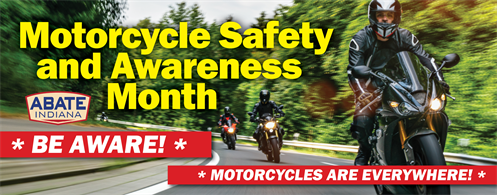
You should know what to expect in May, as each year, we recognize Motorcycle Safety and Awareness Month. This is as proclaimed by Indiana Governor Mike Braun and the National Highway Traffic Safety Administration (NHTSA). Spring is a good time to remind motorists who have not really been looking for two-wheeled traffic since last fall and motorcyclists who may not have done a lot of riding over the last six to seven months.
Drivers need to remind themselves to “Be Aware—Motorcycles Are Everywhere,” just like the bumper sticker says. Right-of-way violations by the “other vehicle” are still the predominant cause of multiple-vehicle crashes involving motorcycles. We need to do all that we can to make ourselves visible to the motoring public so they are able to see us more readily. This includes equipment (bright-colored bike, auxiliary lighting, etc.), gear (brightly colored helmet, retro-reflective material, etc.), and our position (left part of the lane, etc.).
Motorcyclists need to be sure that their machines are “road-ready”. Some preventative maintenance and a spring tune-up may save some headaches that occur when you experience an “avoidable” breakdown. A bike in good condition is also going to perform better and provide for a better response to situations that may develop. Ensuring that everything functions as it should is necessary, but tires may be the most critical and most overlooked piece of safety equipment.
The tires on our cars are important, as the failure of one can result in compromising control of the vehicle. However, automobiles (most of them at least) have four tires, so if one is “lost,” there are still three. This is not the case with a motorcycle. Given that we only have two tires, and they both have vital roles, the loss of either one can be disastrous. Check the condition of your motorcycle’s tires frequently, but even more importantly, check the air pressure. Improperly inflated tires (over-inflated or under-inflated) can affect performance, handling, and tire life and increase the possibility of a failure (blowout).
Our machine is not the only thing we have to get ready before we ride. We need to get ourselves ready. This includes mental readiness as well as physical readiness. That means we need to be in shape to physically handle the motorcycle and have the stamina to endure the length of the ride we intend to embark upon. Your mind should be clear and focused on the task at hand. Don’t overlook the significance of this. You can get yourself into a lot of trouble if your body or mind is not prepared for the journey you are beginning.
Remember that a motorcycle rider course is not only for those persons wishing to learn how to ride initially, but also serves as a great “refresher” to help current riders “knock the rust off”, break bad habits and learn or reinforce skills and strategies. Check out the education page at www.ABATEonline.org for more information.
Inattentive drivers, rusty riders, and dusty machines are not the only challenges to early-season motorcycling. The roadway itself can present problems. We always warn about debris left over from the winter. This is often due to abrasives (sand) put on the road for traction during slick winter conditions. This often collects, especially in corners, and can result in a loose surface, reducing traction for single-track vehicles. The last couple of years have seemed to produce an increased number of potholes. They also appear to be larger and deeper than I remember traditional potholes being. While these can be a jolting nuisance to an automobile, they can be lethal to a motorcyclist. Please be aware and remain extra attentive to these life-threatening hazards.
NHTSA recently released statistics for 2023. Motorcycle numbers have set a new record in each of the last four years, but not in a good way. Motorcyclist fatalities increased by 1.3% in 2023 over 2022. While this may seem to be a small number, it does represent 84 lives lost. No matter how small the rise, with virtually ALL other categories showing decreases, this is not good for motorcyclists.
This year, we have already recorded a significant number of fatal motorcycle crashes in Indiana, starting as early as January. A substantial number of these have been in Marion County. The causes of these crashes have run the gamut from right-of-way violations to rider error to surface conditions. One of these involved a motorcycle and a bicycle, and another was a double fatality wherein the operator and passenger of the motorcycle were both killed.
ABATE of Indiana has been delivering this message for 50 years now and has been providing motorcycle rider education for 46 of those years. With nearly 150,000 riders trained, we continue to encourage riders to be trained, licensed, and free of impairments, and drivers to be aware and share the road. The message hasn’t really changed, and knowing your limits and riding within those limits remains good advice. Take responsibility for your own safety.
Ride Safe,
Ride Free,
Jay Jackson
